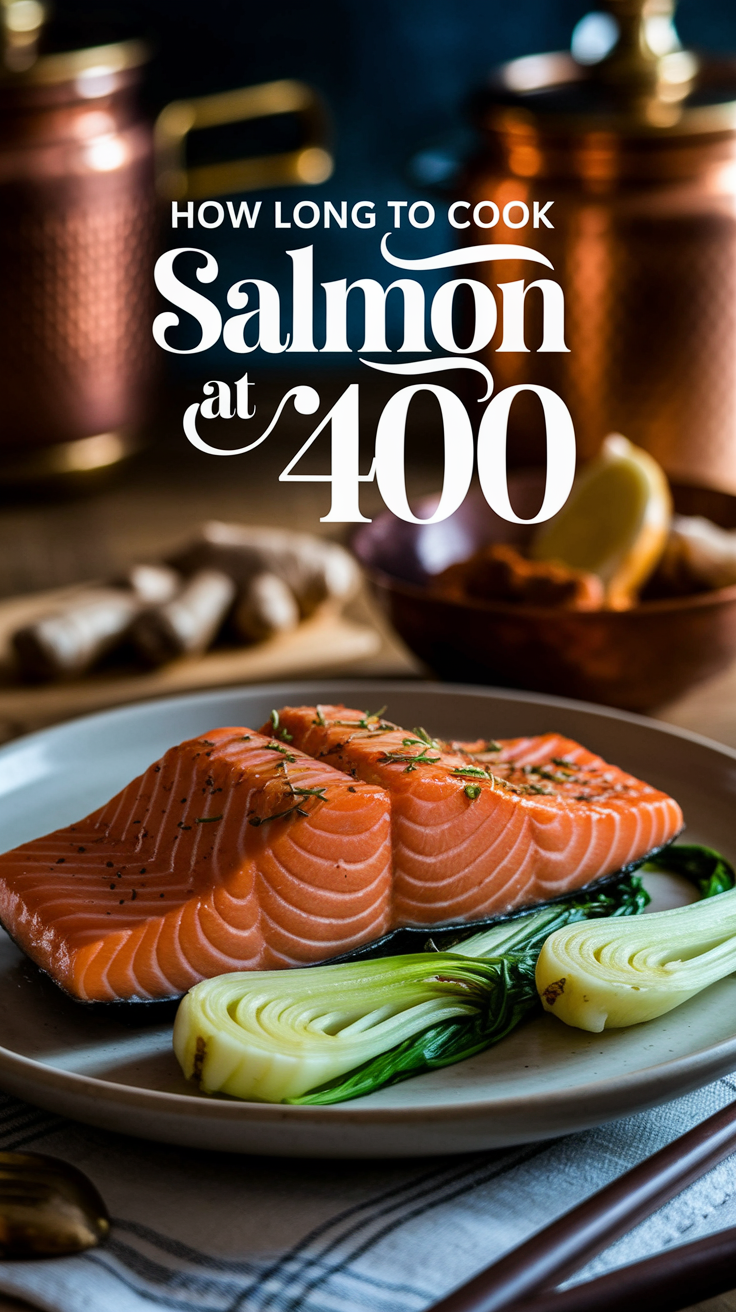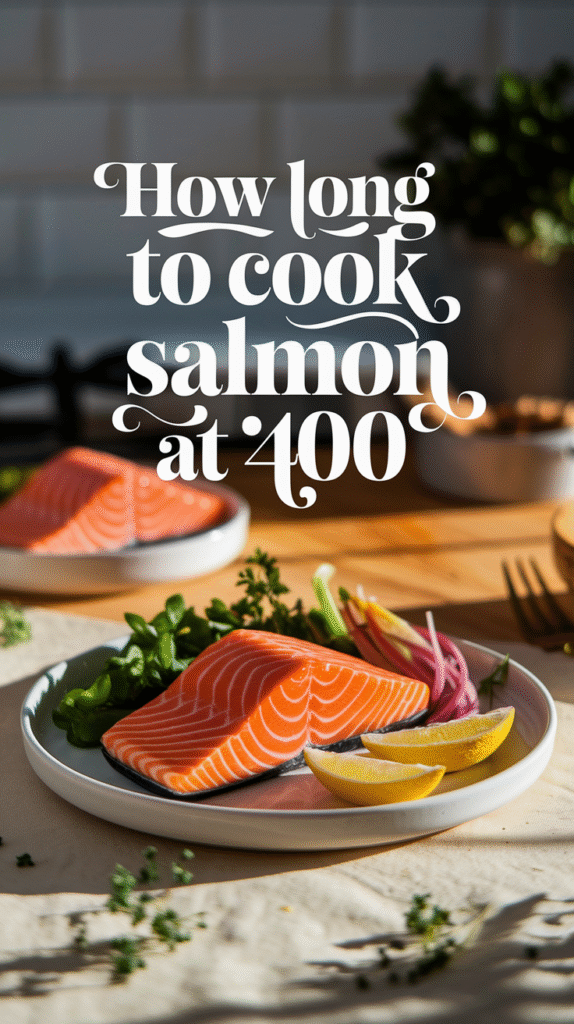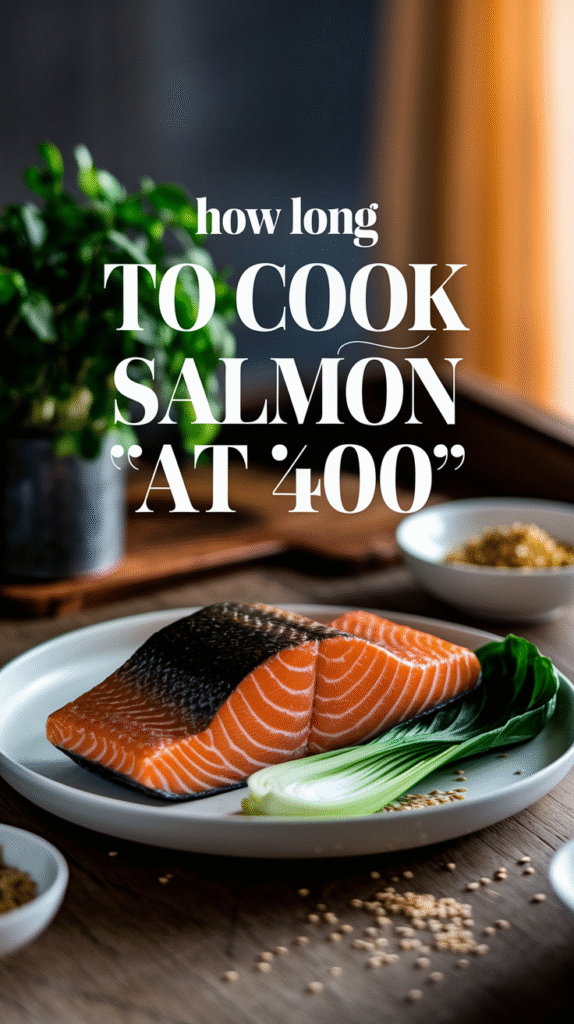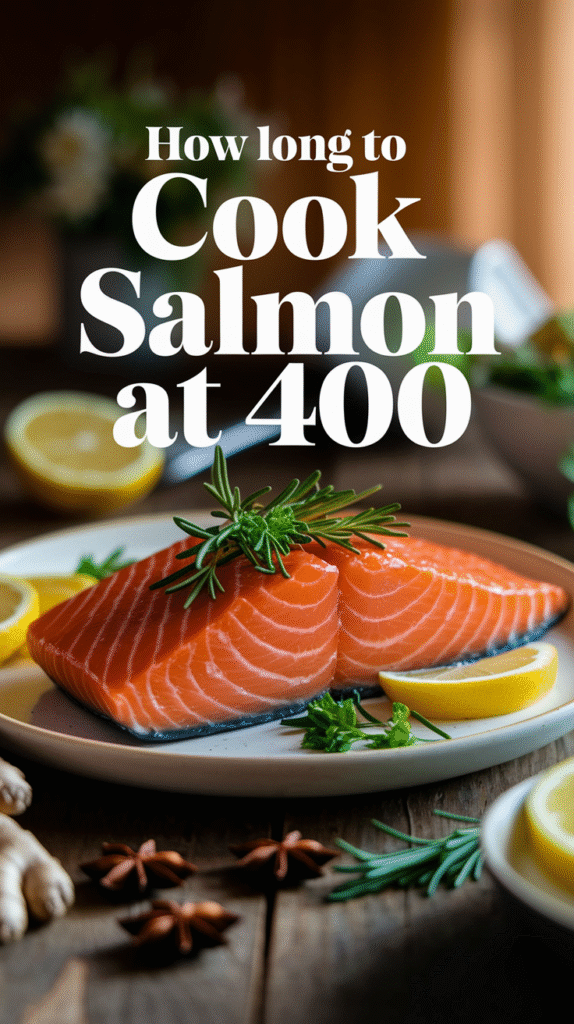When it comes to cooking salmon, many people wonder about the best methods and optimal temperatures to achieve perfectly cooked fish. One popular temperature is 400°F, which can provide a deliciously flaky and moist outcome. Knowing how long to cook salmon at this temperature is key to enjoying a meal that is both flavorful and healthy.
The general rule of thumb is to cook salmon for about 15 to 20 minutes at 400°F, depending on the thickness of the fillet. A standard serving of salmon is typically around 6 ounces, and the cooking time can vary based on whether it is skin-on or skinless, as well as whether it is fresh or frozen.
Cooking Times Based on Thickness
Here’s a simple chart to help you determine how long to cook salmon at 400°F based on fillet thickness:
| Thickness of Salmon | Cooking Time at 400°F |
|---|---|
| 1 inch | 15-18 minutes |
| 1.5 inches | 18-20 minutes |
| 2 inches | 20-25 minutes |
Always keep in mind that the salmon is ready to eat when it flakes easily with a fork and its internal temperature reaches 145°F. If you prefer medium-rare salmon, you can remove it from the oven around 130°F, as it will continue to cook while resting.
Preparation Steps for Cooking Salmon
Preparing salmon for cooking is just as important as knowing the cooking time. Follow these steps to make sure your meal is as enjoyable as possible:
- Start by preheating your oven to 400°F.
- Line a baking sheet with parchment paper for easy cleanup.
- Place the salmon fillet skin-side down on the sheet.
- Drizzle with olive oil and season with salt, pepper, and any other preferred spices or herbs, such as garlic or dill.
- If using a marinade, let the salmon soak for about 30 minutes before cooking for added flavor.
Additional Cooking Methods
Beyond just roasting in the oven, you have other options for cooking salmon that can also use the same temperature:
- Grilling: Preheat the grill to 400°F, and cook the salmon for 4-6 minutes on each side, depending on thickness.
- Pan-searing: Heat a skillet over medium-high heat and cook each side for about 4-5 minutes until golden brown.
- Baking: For even more flavor, wrap the salmon in foil with herbs and lemon slices before baking.
Checking Doneness
It’s important to check the doneness for salmon, as overcooking can lead to dry fish. Here are three practical ways to check if your salmon is cooked perfectly:
- Fork Test: Gently use a fork to flake at the thickest part of the fish. If it flakes easily, it’s done.
- Thermometer: Use a food thermometer to check internal temperature. Aim for 145°F for fully cooked salmon or around 130°F for medium-rare.
- Visual Inspection: Look for a change in color. Salmon should transition from a translucent pink to a more opaque color as it cooks.
Salmon into your diet is an excellent choice, packed with omega-3 fatty acids and high in protein. With the right cooking time at 400°F, you can enjoy the health benefits and incredible flavors of this fish. Remember, patience is key, so don’t rush the cooking process!
For more delicious salmon recipes and tips, check out Salmon Recipes or explore cooking techniques at The Kitchn.
The Best Techniques for Baking Salmon
Baking salmon is a delicious and healthy cooking method that can yield mouthwatering results. By employing the right techniques, you can enhance the flavors and textures of this popular fish. Below are some of the best techniques for baking salmon to ensure a delightful meal every time.
Choosing the Right Type of Salmon
First, it’s important to select the right type of salmon for baking. Different species offer various flavors and textures. Here are a few to consider:
- King Salmon: Known for its rich, buttery flavor.
- Sockeye Salmon: Offers a vibrant color and a bold taste.
- Coho Salmon: Mild in flavor but still has excellent fat content.
- Pink Salmon: More affordable, with a light taste.
Choosing fresh, high-quality fish can make a significant difference in the final dish.
Perfecting the Temperature
When it comes to baking salmon, temperature plays a vital role in achieving the perfect doneness. A common temperature recommendation is 400°F (200°C). At this temperature:
- Salmon typically bakes in about 12 to 15 minutes.
- The exterior becomes crisp while retaining moistness inside.
Using a food thermometer, aim for an internal temperature of 145°F (63°C) in the thickest part of the fish for optimal results.
Preparing the Salmon
Proper preparation can elevate the flavors and improve presentation. Here are steps to consider:
- Thawing: If using frozen salmon, thaw it overnight in the fridge or under cold running water.
- Marinating: Consider marinating the salmon for at least 30 minutes or up to 2 hours. A simple marinade can consist of olive oil, lemon juice, garlic, and herbs.
- Seasoning: Sprinkle salt, pepper, and your choice of spices evenly. Fresh herbs like dill or parsley can add an aromatic touch.
Using the Right Baking Dish
The choice of baking dish can influence cooking time and results. Consider these options:
- Glass Dish: Ideal for even heat distribution. Just ensure you reduce the cooking time slightly.
- Metal Baking Sheet: Provides a nice crisp on the edges and is great for high heat.
- Cast Iron Skillet: Perfect for a rustic presentation and even cooking.
Adding Flavor with Toppings
Enhancing the salmon’s natural flavor can be easily achieved by adding toppings before baking:
- Herb Crust: Blend chopped herbs with breadcrumbs and olive oil for a crunchy topping.
- Vegetables: Thin slices of bell peppers, tomatoes, or citrus can be placed on top for added flavor and moisture.
- Nuts: Chopped almonds or pine nuts add an interesting texture and nutty flavor.
Covering for Moisture
To ensure your salmon retains moisture, consider covering it with foil or parchment paper during the first half of the baking time. This technique traps steam, allowing the fish to cook evenly while preventing it from drying out.
Final Touches
After baking, let the salmon rest for a few minutes before serving. This allows the juices to redistribute, ensuring a moist center. You can also drizzle additional lemon juice or a light sauce over the top right before serving for an extra burst of flavor.
Serving Suggestions
Baked salmon pairs delightfully with various sides. Consider serving it with:
- Steamed vegetables
- Quinoa or brown rice
- Mashed potatoes
For more in-depth recipes and salmon cooking techniques, you can visit sources like Food Network or AllRecipes.
By mastering these techniques, you can create a perfect baked salmon dish that is sure to impress at your next meal. Happy cooking!
Flavor Pairings: Enhancing Your Salmon Dish
Salmon is a beloved fish known for its rich flavor and health benefits. To elevate your salmon dishes, exploring various flavor pairings can be transformative. Here are some delightful combinations that enhance your meal, making it even more satisfying and memorable.
Classic Pairings
When thinking about how to enhance your salmon, consider these classic flavor companions:
- Herbs: Fresh dill, parsley, or tarragon can brighten up the flavors of your salmon.
- Citrus: Lemon and lime juice add a refreshing acidity that balances the fat in salmon.
- Garlic: Roasted garlic or minced raw garlic brings a delightful warmth.
- Butter: A drizzle of melted herb-infused butter can provide richness.
Sweet and Spicy Contrasts
Sweet and spicy flavors work beautifully with salmon. Here are some combinations to try:
- Maple Syrup and Sriracha: A glaze made with these two can create an exciting blend of sweet and heat.
- Brown Sugar and Soy Sauce: This mixture creates a savory-sweet marinade that caramelizes beautifully.
- Honey and Chili Flakes: Drizzling honey mixed with chili flakes can add depth and complexity.
Vegetable Companions
Adding vegetables not only enhances the dish aesthetically but also provides additional flavors and nutrients. Consider these delicious pairings:
- Asparagus: Grilled or roasted asparagus adds a lovely texture and a slight bitterness.
- Brussels Sprouts: Their nutty flavor complements salmon well, especially when caramelized.
- Spinach: Sautéed spinach with garlic is a great side to balance the fish’s richness.
Global Influences
Global flavors can take your salmon dish to the next level. Here are international flavor pairings you can experiment with:
- Miso Glaze (Japanese): A miso glaze adds umami depth, perfect for a sophisticated touch.
- Chimichurri (Argentinian): This sauce made of parsley, garlic, vinegar, and oil brings freshness.
- Harissa (North African): A spicy chili paste can give your salmon a flavorful kick.
Accompaniments That Shine
Don’t overlook the side dishes that complement your salmon. Here are some great options:
| Accompaniment | Flavor Profile |
|---|---|
| Quinoa Salad | Nuts and Citrusy |
| Roasted Potatoes | Crispy and Savory |
| Couscous | Fluffy and Herbaceous |
Involving Sauces and Condiments
Choosing the right sauce or condiment can elevate the overall flavor of your salmon. Here are a few must-try options:
- Tartar Sauce: Bring a creamy tang that can pair nicely with grilled salmon.
- Yogurt Dill Sauce: A refreshing counterpart that adds a cool creaminess.
- Teriyaki Sauce: Excellent for a sweet-savory marinade!
For additional inspiration and recipes focused on flavor pairings, explore resources like Love and Lemons or Serious Eats. These websites provide various ideas to help enhance your salmon dishes with unique, delightful flavors.
Whether you’re grilling, roasting, or baking, the right flavor pairings will make your salmon dish stand out. Experiment with these combinations, and you may just find a new favorite way to enjoy this healthy, tasty fish!
Health Benefits of Eating Salmon Regularly
Regularly incorporating salmon into your diet can have numerous health benefits. This delicious fish is packed with essential nutrients, making it a fantastic choice for those who want to improve their overall well-being. Let’s explore the reasons you should consider adding salmon to your meals.
Rich in Omega-3 Fatty Acids
Salmon is one of the best sources of omega-3 fatty acids, which are essential for your body. These healthy fats promote heart health by reducing inflammation and lowering blood pressure. Omega-3s also play a crucial role in brain function and development.
Key Benefits of Omega-3 Fatty Acids:
- Help reduce the risk of cardiovascular diseases.
- Improve brain health and can support mood enhancement.
- Decrease inflammation throughout the body.
High in Quality Protein
Protein is vital for muscle building and repair, and salmon is a fantastic source. Just a serving of salmon contains a substantial amount of high-quality protein, which is crucial for maintaining healthy bones and muscles.
Benefits of Protein in Salmon:
- Supports muscle growth and recovery.
- Boosts the immune system’s functionality.
- Helps maintain healthy skin, hair, and nails.
Packed with Vitamins and Minerals
Salmon is loaded with essential vitamins and minerals that are beneficial for your health. Some of these include vitamin B12, selenium, and vitamin D.
Important Nutrients Found in Salmon:
| Nutrient | Benefit |
|---|---|
| Vitamin B12 | Crucial for red blood cell formation and proper nerve function. |
| Selenium | Antioxidant properties that protect against cell damage. |
| Vitamin D | Supports calcium absorption for strong bones. |
May Help Reduce the Risk of Chronic Diseases
Regular consumption of salmon has been linked to a lower risk of various chronic diseases. The omega-3 fatty acids found in salmon can help protect against heart disease and other health issues.
Specific Chronic Diseases Linked to Salmon Consumption:
- Heart Disease
- Type 2 Diabetes
- Certain Types of Cancer
Supports Healthy Aging
Eating salmon regularly can also promote healthy aging. The anti-inflammatory properties in salmon contribute to better skin health and can reduce the risk of age-related conditions.
Benefits for Aging Populations:
- Helps maintain cognitive function as you age.
- Improves joint health and reduces arthritis symptoms.
- Enhances skin elasticity and appearance.
Easy to Prepare and Versatile
Another reason to love salmon is its versatility in the kitchen. There are countless ways to enjoy it, whether you bake, grill, or pan-sear it. You can easily pair salmon with vegetables or whole grains to create a balanced meal.
Suggested Salmon Recipes:
- Grilled Lemon Herb Salmon
- Baked Honey Garlic Salmon
- Salmon and Asparagus Foil Packets
Salmon into your diet not only makes meals flavorful but can also have incredible health benefits. For more detailed nutritional information about salmon, visit Healthline and for recipes, check out Allrecipes.
Eating salmon can be a delicious step towards a healthier lifestyle. So, next time you’re planning your meals, consider adding this superfood to your plate!
Tips for Selecting Fresh Salmon at the Market
When shopping for salmon, selecting fresh fish is crucial for both flavor and health. Here are some actionable tips on how to pick the best salmon at your local market.
First, understand the different types of salmon available. You’ll often see Atlantic salmon, king salmon, sockeye, coho, and pink salmon. Each variety has its taste and texture, so knowledge about these types can help you choose according to your preferences and cooking style.
Look for Color
Fresh salmon should have a vibrant color. Here’s a quick guide:
- Atlantic Salmon: Bright orange to pink.
- King Salmon: Rich deep orange to red.
- Sockeye Salmon: Bright red to dark red.
- Coho Salmon: Medium red.
- Pink Salmon: Light pink.
When you see dull color or fading, it may indicate that the fish is not fresh.
Check for Firmness
One of the best indicators of fresh salmon is its firmness. Gently press the fillet with your finger:
- If the flesh springs back, it’s fresh.
- If it leaves an imprint and doesn’t bounce back, consider another piece.
Smell Matters
The aroma of salmon should remind you of the ocean, not fishy or sour. A strong, unpleasant smell is a significant red flag. If it smells overly strong, it may not be fresh.
Inspect the Skin
The skin of fresh salmon should look shiny and vibrant. Also, you should be able to see the scales clearly. If the skin looks dull or is peeling, it could be a sign that the salmon isn’t fresh.
Check for Gaps and Transparency
When examining salmon fillets, look closely for gaps in the flesh. The meat should be dense and cohesive, without gaps or tears. Additionally, fresh salmon should have a slight sheen and should appear moist but not slimy.
Ask Questions
Don’t hesitate to ask the fishmonger about the salmon. Questions you might consider include:
- When was this salmon caught?
- Is it farmed or wild-caught?
- How has it been stored?
A reputable seller will be more than willing to share information that can help you make a sound decision.
Consider Frozen Salmon
If your market doesn’t have fresh salmon available or it looks questionable, consider using frozen salmon. High-quality frozen salmon is often caught and then flash-frozen, preserving its freshness. Always check the packaging for signs of freezer burn or discoloration.
Visit Reliable Sources
Make it a habit to shop at reliable markets and stores that prioritize fresh seafood. Leading grocery chains and local fish markets often maintain higher standards regarding the quality of fish. For additional information on seafood quality, you can explore resources such as Seafood Watch .
Storage Tips
Once you have your fresh salmon, store it properly to maintain its quality:
- Keep it in the coldest part of your refrigerator.
- Cover it with plastic wrap or aluminum foil.
- If not cooking it within 1-2 days, freeze it immediately.
Engaging in these practices will not only enhance your meals but also ensure that you consume high-quality salmon, which is beneficial for health. Being knowledgeable about how to choose fresh salmon is essential for anyone who appreciates good food.
Remember, good salmon can make a world of difference when you’re preparing your favorite dishes!
Conclusion
Cooking salmon at 400°F can yield a perfectly flaky and flavorful result when you follow the right techniques and timings. You’ve learned that optimal cooking times typically range from 12 to 15 minutes, depending on the thickness of the fillet. Baking at this temperature allows you to achieve that tender texture while locking in moisture and flavor.
Alongside mastering the cooking time, utilizing effective baking techniques, such as using parchment paper or foil, can enhance your dish’s flavor and ease of cleanup. Complementing salmon with delightful flavor pairings, like lemon, garlic, or herbs, not only elevates its taste but also brings an array of fresh textures to your plate.
Moreover, consuming salmon regularly isn’t just a treat for your taste buds; it’s a boon for your health as well. Rich in omega-3 fatty acids, vitamins, and minerals, salmon contributes to heart health and overall wellness.
Knowing how to select fresh salmon at the market makes all the difference in your cooking experience. Look for vibrant color, firm texture, and a clean, ocean-like scent to ensure you’re getting high-quality fish that will shine in your dishes.
By applying these insights, you can elevate your salmon preparation from basic to gourmet, ensuring each meal is not only delicious but also nutritious. Enjoy experimenting with flavors and techniques, knowing you’re making a healthy choice for you and your loved ones!







Leave a Reply